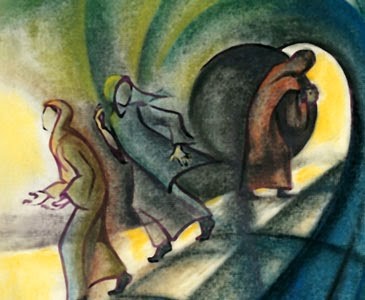 This is the year in which we primarily read from the Gospel of Mark – at least on Sundays. But since it is the shortest of the gospels, we supplement it with a lot from the other three gospels. Like this morning, we read the traditional Johannine scene of Mary Magdalene mistaking Jesus for the gardener. We get to encounter the risen Jesus, the first witness, some next steps, and all quickly moving to proclamation “I have seen the Lord.”
This is the year in which we primarily read from the Gospel of Mark – at least on Sundays. But since it is the shortest of the gospels, we supplement it with a lot from the other three gospels. Like this morning, we read the traditional Johannine scene of Mary Magdalene mistaking Jesus for the gardener. We get to encounter the risen Jesus, the first witness, some next steps, and all quickly moving to proclamation “I have seen the Lord.”
“Then they went out and fled from the tomb, seized with trembling and bewilderment. They said nothing to anyone, for they were afraid.” (Mark 16:8)
Mark’s version is unsettling. We get no glimpses of the risen Jesus. Peter and the other disciples are nowhere to be seen. There is no beloved Apostle. When a young man in a white robe tells Mary Magdalene and her two companions that Jesus has been raised from the dead, the women don’t cry out in joy; they respond with “alarm,” “terror,” and “amazement.” The angel’s announcement of the Good News inspires neither belief nor transformation. We witness no Easter proclamation, no narrative arc from hopelessness to certitude. Instead, we witness fear, flight, and silence.
Maybe that is Easter in the shadow of the 2.7 million beloveds we’ve lost worldwide to COVID-19. In the United States, we will celebrate the empty tomb in the wake of two, still-raw mass shootings; disorder at our southern border; protracted unemployment and food insecurity; a deepening crisis of pandemic-induced loneliness, depression, and anxiety; and the ongoing scourge of racial tension, violence, and injustice in our streets and institutions.
In Mark’s gospel, the women have heard the angel’s message, “He is risen” but still need time to process the news of our life and the Good News of God’s incomprehensible work of redemption – colliding in real time with our lives. Maybe we don’t need to proclaim right away. Maybe it’s okay to whisper to ourselves.
Saint Anselm of Canterbury’s motto for the Christian life was “faith seeking understanding.” That seems like a good motto for our time. It allows us to accept where we are in this here and now. Time to ask ourselves, what have I experienced of and with Jesus so far? Can I cling to this faith in light of the world around me, in the light of my experience of God, incomplete though it is? Can I wait in silence as the waves of alarm, fear, amazement, and hope course through me, bringing me slowly, slowly, to resurrection joy?
In John’s gospel the Good News quickly gives rise to proclamation. In Mark’s gospel, faithful people need to process but they too eventually arrive at proclamation.
In time our alarm will subside, our courage will deepen, our wounds will heal, and we, like the women of Mark’s gospel, will learn how to choose hope…. all in good time, holy time.